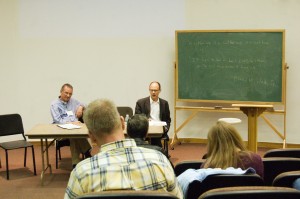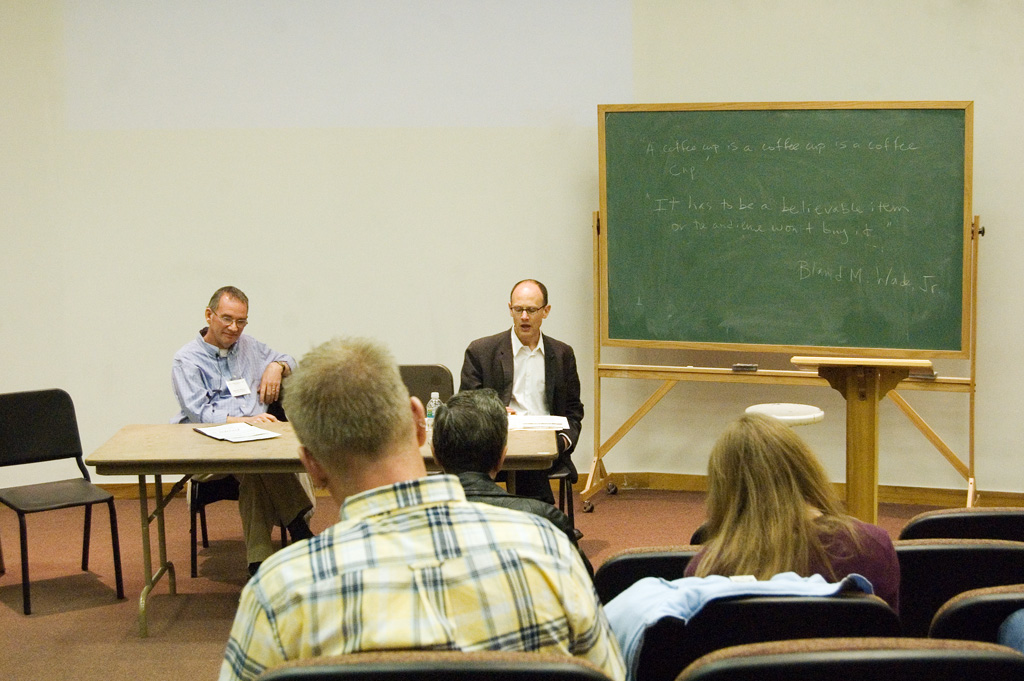
By the end of the 2009 SETC Theatre Symposium, which focused on theatre props, I felt like my brain was full. We heard so many good papers on all aspects of props, from their use by playwrights, their practical application and construction, their historical iterations, and their perception by the audience.
A coffee cup is a coffee cup is a coffee cup
Andrew Sofer began his closing remarks by pointing to a statement Bland Wade had made earlier in the conference: “It has to be a believable item or the audience won’t buy it.” Sofer was struck by Wade’s use of the word “believable” rather than “realistic.” A prop director can find research for an obscure but completely historically accurate object, but if it is out of the realm of what the audience is expecting, they will not believe it. Likewise, we often have to work in more constructed worlds on stage, where time periods are mixed or elements are completely fabricated from imagination, but we still have to provide props which the audience will accept. A prop director’s role is constrained by the audience’s need for mimetic realism.
The Joy of Labor
In regards to the paper I presented, Sofer pointed out the joy of labor and the audience’s appreciation of it. Often, the academic world will focus so much on the meaning of signs and symbols in props that they overlook the audience’s simple joy at seeing well-produced theatre. When props (or any other design element) are well-constructed, meticulously-crafted, and, for lack of a better word, “cool”, the audience has a deeper reaction to the play.
As part of the conference, we attendants were treated to a performance of King Lear by the Wake Forest University Theatre Department. During one of the sword fights, the actor’s sword broke in half, and he was forced to finish the fight with only a hilt. It was an apropos moment for the whole weekend. During the previous day, Bland Wade queried the audience, “How does West Side Story end if the gun doesn’t go off?” It pointed out not only the importance of a prop’s construction to a props director, but also how many plays rely on a prop’s manipulation to further the action of the play. In his closing remarks, Sofer mentioned the broken sword from King Lear and quipped, “After his sword broke, the actor found new meaning to the phrase ‘playing it to the hilt’.”
All that Remains
Finally, the last thing I wanted to mention from the closing remarks is that a prop (or a costume piece) is often the only physical object left from a play’s performance. Many actors, designers, and directors have a prop from a performance they did years ago. We have scripts, we have drawings, and we have photographs, but a prop is the only actual object which remains. In this way, old props are reliquaries and artifacts. When we study historical theatre, such as Ancient Greek, Roman, or Elizabethean theatre, we can hold one of their props and know it was once held and used by an actor in a performance.
That should do it for the bulk of my posts about the Theatre Symposium. I may mention some papers from time to time as it comes up, but next week I’ll go back to more practical prop topics. Ron DeMarco, the prop director at Emerson University, gave me a wealth of material he uses in his class on props, and I’m sure much of it will be of use to you.





